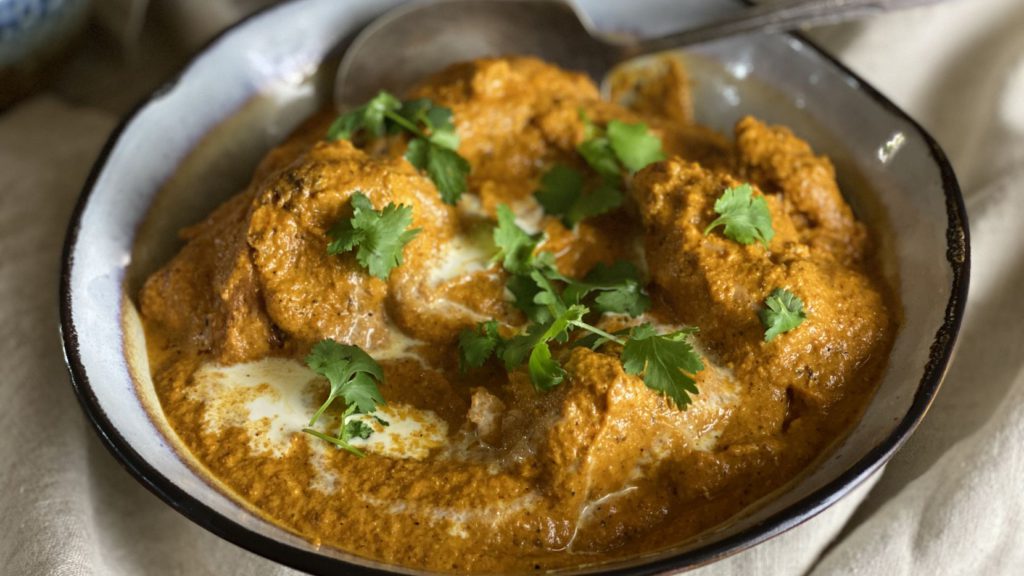Mark your calendar. Marshal your spices. Dust off your Dutch oven or plug in your Instant Pot. Tuesday, Oct. 20, will be the first-ever World Butter Chicken Day.
Butter chicken is the dish known in Hindi as murgh makhani. The rich, creamy, aromatic, gently spiced specialty — in which chicken pieces are simmered in a smooth, buttery, tomatoey gravy — may well be the most popular Indian dish in the universe. It’s certainly one of the most approachable for diners unfamiliar with Indian cuisine, and as a universally beloved comfort dish that’s aromatically transporting, it would seem to be a COVID-era superstar.
Butter chicken has long been featured in Indian restaurants all over the United States. Three years ago, a North Texas blogger’s Instant Pot recipe for it went viral, prompting The New Yorker to profile its author, Urvashi Pitre — also known as “the Butter Chicken Lady.” Dallas Morning News food editor Erin Booke profiled the Keller resident the following month. So butter chicken holds an especially warm place in the hearts of North Texans.
But where did butter chicken come from? Is it truly Indian, and if so, why is it known by such a Westernized name? And how did Oct. 20 come to be celebrated as World Butter Chicken Day?
“Butter chicken was invented by Kundan Lal Gujral at Moti Mahal, which was established in 1920,” says Monish Gujral, the Delhi, India-based chef who presides over an empire of what has become some 250 restaurants around the world; he is Kundan Lal’s grandson. “This month marks the 100 years of Moti Mohal.”
World Butter Chicken Day, in other words, celebrates the centenary of the restaurant that birthed the dish.

Though it is exceedingly rare to be able to trace the history of any dish with any kind of precision, butter chicken’s origin story seems to be undisputed by culinary historians. Monish Gujral laid it out in the introduction to his 2009 cookbook, On the Butter Chicken Trail, and I filled in the details with him beginning with a phone interview in April for a story I wrote for Cooks Without Borders, and subsequently in a series of phone and email interviews.
It’s quite an interesting tale — one that starts in Peshawar, a city in what is now Pakistan, and which used to be part of India. There, 100 years ago this month, a fledgling restaurateur, Mokha Singh Lamba, opened a dhaba — a small roadside restaurant, bringing on Kundan Lal Gujral — Monish’s grandfather — to work there. Kundan Lal was the first person known to use a tandoor oven to roast chickens; previously, tandoors had only been used to bake bread. Tandoori chicken was the result. The invention was such a hit that it put Moti Mahal, as the dhaba came to be called, on the map.
But the chef had a sticky problem: what to do with the leftover tandoor-roasted chickens, which dried out by the following day? A sauce was needed to revive them, and Gujral concocted a rich, tomatoey, buttery, beautifully spiced gravy that did the trick. Murgh makhani — or butter chicken, as it was also called (this was during British colonial rule) — made Moti Mahal famous throughout India.
During partition in 1947 (when Pakistan and India were separated), Gujral — who had by then inherited the restaurant — had to flee. He and his family moved to Delhi, where he opened the flagship Moti Mahal.
By the following year, wrote then-Bombay Times editor Mark Manuel in the foreword to On the Butter Chicken Trail, the 400-seat restaurant had become a favorite of luminaries and heads of state, including Jawaharlal Nehru, India’s first prime minister. Presidents Kennedy and Nixon dined there in subsequent years. Indira Gandhi, Nehru’s daughter and India’s prime minister from 1980 to 1984, was a close friend of Kundan Lal, says his grandson.

Since then, Moti Mahal has grown into an empire of some 250 restaurants around the world, presided over by Monish — who went to work for his grandfather in 1983, eventually becoming chef. [This BBC video, narrated in Urdu, begins in Peshawar at the original site and ends at Moti Mahal’s Delhi flagship.]
In the course of subsequent correspondence, Monish informed me that Moti Mahal would be celebrating its 100-year anniversary this month, and I suggested creating an annual World Butter Chicken Day in commemoration. (A bit of research led me to understand that’s how these food holidays get created: Someone just creates them, and they either catch on or they don’t.)
The exact date in October 1920 that the original Moti Mahal debuted is not known, says Monish, who jumped at the idea. He chose the 20th because that’s the birthday of his own son, who Monish says “looks like his great-grandfather.”

So, how to celebrate?
You could do what legions of Pitre’s fans will likely be doing: tossing spices, garlic, ginger and chicken in an Instant Pot, letting it do its magic for 10 minutes, then blitzing the sauce with an immersion blender.
Or you could make a butter chicken that’s much closer to Moti Mahal’s original murgh makhani, adapted from Monish Gujral’s version in On the Butter Chicken Trail. Doing it all the way means tracking down dried fenugreek leaves, marinating the chicken for four hours, and toasting and grinding spices to make your own garam masala.
Instead, what I’ll be doing is making World Butter Chicken: a simplified version I developed for the occasion. It’s much less complicated and much quicker than Gujral’s excellent version, and if my extremely critical family is to be believed, it’s every bit as wonderful.
It can be achieved in 90 minutes or less, an hour of which is unattended marinating time. That’s when you can make the cucumber raita and coriander chutney that are great to serve with it, and get basmati rice ready to cook. While the chicken thighs roast (20 to 35 minutes depending on their size), you can make the sauce and the rice.
Don’t want to cook? Support a local independent Indian restaurant struggling through COVID by calling and ordering butter chicken and accompaniments to go. If you phone directly or order online from the restaurant’s website rather than using one of the delivery services, more of your dollars will go directly to the restaurant.
Whether you cook your butter chicken or order out, another great way to commemorate World Butter Chicken Day is to help fight world hunger: Make a tax-deductible donation to World Food Programme or another anti-hunger nonprofit organization.
Congratulations to Moti Mahal on its first 100 years. And happy World Butter Chicken Day!

World Butter Chicken
For the tandoori chicken thighs:
1 1/2 tablespoons freshly squeezed lime juice
1/2 teaspoon paprika, preferably smoked
1/2 teaspoon cayenne pepper
1 teaspoon salt
2 pounds boneless, skinless chicken thighs
1/2 cup yogurt (whole milk or low fat)
2 tablespoons Ginger-Garlic Paste (recipe follows)
1/2 teaspoon salt
1 teaspoon Punjabi-style garam masala, commercial (Penzeys makes an excellent one) or homemade
For the butter chicken:
2 tablespoons canola or other neutral oil
1 medium onion, diced (about 1 1/4 cups)
1 can diced tomatoes, preferably fire-roasted, including the juices
1 1/2 teaspoons salt
1 tablespoon Ginger-Garlic Paste (recipe follows)
2 teaspoons paprika, preferably smoked
1 teaspoon cayenne pepper
1 tablespoon garam masala, preferably Punjabi-style* or homemade
1 teaspoon ground cumin
1 recipe Tandoori Chicken Thighs
3 tablespoons unsalted butter, cut into a few pieces
1/2 cup heavy cream (plus additional to swirl in for garnish, if you like)
Cilantro leaves for garnish
Make the tandoori chicken thighs: In a small bowl, combine the lime juice, paprika, cayenne and salt. Pat the chicken thighs dry, place them in a shallow dish, unfold them, and distribute half the marinade over them, rubbing it into the flesh. Turn the thighs over and repeat with the rest of the marinade. Set aside.
In the same small bowl (no need to wash it), combine the yogurt, Garlic-Ginger Paste, salt and garam masala. Rub the mixture onto both sides of the chicken thighs (yes, on top of that first marinade), cover with plastic film and refrigerate 1 hour.
Heat the oven to 475 F with a rack set in the middle, and set a rack on a rimmed baking sheet. When the oven is hot, place the chicken thighs on the rack, folding them back up like thighs and leaving space between them. Roast until they’re cooked through (an instant-read thermometer stuck in the thickest part should read 165 F), 20 to 35 minutes depending on the size of the thighs. Remove from the oven and set aside.
While the chicken roasts, prepare the sauce. In a Dutch oven or heavy medium-large sauce saucepan, heat the oil over medium heat. Add the onion and sauté until the onion is soft and translucent, about 6 minutes.
Stir in the diced tomatoes and their liquid and the salt, and simmer, stirring occasionally, over medium heat about 10 minutes. Remove from heat, stir in 1/2 cup of water and use an immersion blender to purée the mixture to a smooth sauce. Alternatively, transfer the mixture to a blender or food processor, using a rubber spatula so nothing’s left on the sides, pureé to smooth and return the sauce to the pot. Stir in the Ginger-Garlic Paste, paprika, cayenne, garam masala and cumin. Stir in the accumulated juices from the chicken’s baking sheet (if any), bring back to a simmer over medium heat and cook for 2 minutes. (At this point you can remove from heat and reheat when you’re nearly ready to serve.)
Transfer the chicken thighs to the sauce, bring back to a simmer and cook for 3 or 4 minutes, or until the chicken is heated through. Add the butter and cook over medium-low heat, stirring, till it melts. Taste and adjust seasoning. Stir in the cream and remove from heat immediately.
Garnish with cilantro leaves, drizzle on a little more cream, if you like, and serve with rice and/or naan.
Ginger-Garlic Paste
Note: If you are using a power blender, such as a Vitamix, no need to peel the ginger; just wash and trim it. Less powerful blenders and food processors may leave pesky flecks of skin.
2 ounces ginger, roughly chopped
2 ounces peeled garlic cloves (about 14 medium cloves), roughly chopped
Place the ginger, garlic and 2 ounces of water in a blender or mini chop and blend until the mixture is a smooth paste. Keep any unused Ginger-Garlic Paste covered and refrigerated. It will keep for about 2 weeks.
SOURCE: Cooks Without Borders





